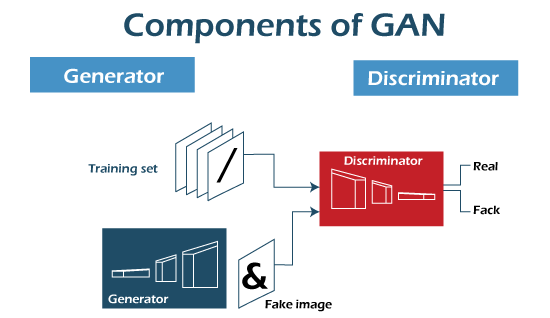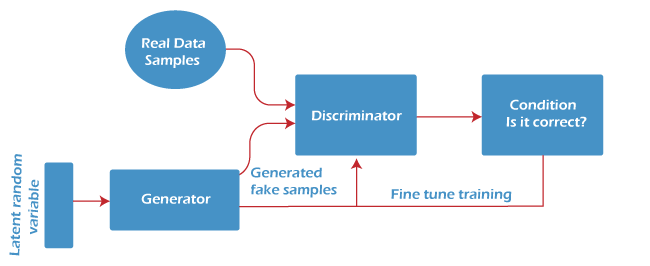Introduction to Generative Adversarial Network (GAN)In Machine Learning, there are different ways by which it can predict output on the unseen dataset. Further, Deep Learning and Neural networks, a part of Machine Learning, are such powerful technologies that are capable of generating new human faces from scratch that did not even exist before but appear natural with the help of training data, and this is possible with the technology named GAN or Generative Adversarial Networks. Generative adversarial networks (GANs) are among the most popular and recent unsupervised machine learning innovations developed by Ian J. Goodfellow in 2014.GAN is a class of algorithmic machine learning framework having two neural networks that connect and can analyze, capture and copy the variations within a dataset. Further, both neural networks work against one another in GAN machine learning, hence called adversarial networks. It is most often used in various ML applications, such as image generation, video generation, and speech generation. In this topic, we are going to discuss Generative Machine Learning (GAN), applications of GAN in machine learning, how GANs work, components of GANs, steps for training and prediction via Generative Adversarial Networks (GANs), challenges faced by generative adversarial networks, types of GANs, etc. So, let's start with a quick introduction to Generative adversarial networks (GANs) in Machine Learning. What are Generative Adversarial Networks (GANs) in Machine Learning?A Generative Adversarial Network or GAN is defined as the technique of generative modeling used to generate new data sets based on training data sets. The newly generated data set appears similar to the training data sets. GANs mainly contain two neural networks capable of capturing, copying, and analyzing the variations in a dataset. These two neural networks are known as generators and discriminators, and both of them compete with each other. The term Generative Adversarial Network consists of three words, and each of them has its separate meaning, which is as follows:
Why need GANs?With the advancement of technology, there are various possible ways by which ML algorithms and neural networks can be fooled into misclassifying data just by introducing some noise in the training datasets. But with the innovations in machine learning, various techniques are being developed that can prevent the chances of misclassifying the images. Hence, GANs were discovered to generate new data sets, which look like training data sets and hence can start visualizing new patterns like training data. Applications of GANsGANs are a much popular approach in machine learning and have various applications in real-world scenarios. Below are a few most famous applications of generative adversarial networks (GANs), which are as follows:
Besides these applications, there are so many miscellaneous applications of GANs in machine learning, which are as follows:
As soon as research on GANs in machine learning is going at its peak, in the future, we will see GAN applications in producing high-quality video, audio, and images also. Further, Microsoft has already collaborated with OpenAI to work on GPT and explore the power of GAN at the next level. Components of Generative Adversarial Networks (GANs)Generative adversarial networks are primarily made from two components, i.e., generator and discriminator. As the name suggests, the generator generates a fake output of unseen data based on training data sets and makes the discriminator fool to understand this fake data as accurate. Further, the discriminator acted as a cop and used to discriminate the training data and generated data, identify the abnormalities in the samples created by the generator and classify them as Fake or genuine. However, this entire process continues till the generator wins and ultimately makes a fool of the discriminator on fake data. Components of GANs are as follows: 

This process continues until the generator makes the discriminator fool, and once this is achieved generalized GAN model is created. Training of Generative adversarial networks (GANs)We have now discussed the basic concepts of generative adversarial networks (GANs) and their components. Now it's time to move further and learn about training and predictions of GANs in machine learning. Here are a few essential steps to train GANs components individually. These are as follows: Step-1: Identify the actual problems: This is essential in working on real-time projects. If you can identify the actual problems, you can only solve this efficiently. In GANs, whatever you are aiming for, you need to define that, which means What you want to create, like audio, poem, text, or image, is a type of problem. Step-2: Choose appropriate GAN architecture: Although there are so many architectures of GANs exist, such as DCGAN, Conditional GAN, Unconditional GAN, Least Square GAN, Auxilary Classifier GAN, Dual Video Discriminator, SRGAN, Cycle GAN, and Info GAN, we have to define which type of GAN architecture we are using in our project. Step-3: Give training to discriminator on real data sets: The discriminator is always given training on real data sets, and it only contains a forward path mechanism and does not follow backpropagation in n epochs. Further, it is only provided with actual data having zero noise or fake content. Further, for fake images, the discriminator uses instances created by the generator as negative output. Some actions happen during the discriminator training process.
Step-4: Provide training to the generator: The training process of the generator starts with the introduction of some fake inputs. Initially, we give some fake input to the generator, but later it generates some fake output by adding some random noise. Further, whenever the generator gets trained, discriminators remain inactive, while the generator remains inactive when the discriminator gets trained. While providing training to generator training using any random noise as input, it aims to convert it into meaningful data to provide meaningful output, and the process takes time and runs under many epochs: Below are a few simple steps to train the generator on fake input as follows:
Step-5: Provide training to discriminators on fake inputs: In this step, we pass the samples to discriminators to predict whether the data is real or fake. Further, provide feedback received by decimators to generators again to do modifications in the samples. How do GANs work?As discussed above, GAN contains two neural networks, of which one is called Generator G(x), and another one is called Discriminator D(x). As the name suggests, both of these works in an Adversarial manner. The generator always tries to generate fake data similar to training data to fool the discriminator, i.e., it generates new data instances. Whereas the discriminator aims to identify the fake data from the actual data, i.e., it evaluates the authenticity of data. Both neural networks work simultaneously to learn from complex data, including images, audio, or video files. Let's say we try to generate hand-written numerals similar to as MNIST dataset, which occurred in the real world; now, the discriminator aims to identify the instance of the accurate MNIST dataset as authentic. Meanwhile, the generator creates new synthetic images and passes them to the discriminator. The generator expects these images to be identified as accurate, even if they are fake. It generates as possible hand-written digits to fool the discriminator. The discriminator aims to identify images as fake coming from the generator. The working of GANs can be summarized in the below steps:

Different types of Generative Adversarial Networks (GAN)s
Next TopicMachine Learning for Data Management
|
 For Videos Join Our Youtube Channel: Join Now
For Videos Join Our Youtube Channel: Join Now
Feedback
- Send your Feedback to [email protected]
Help Others, Please Share










